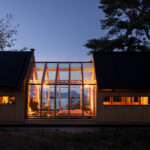This feature has been created in collaboration with urbanNext, a multi-platform aimed at developing, disseminating and distributing content centered on architecture through a focus on the contemporary human milieu and its challenges. Architizer features a weekly discussion from urbanNext’s journals to support its investigation of urban conditions and innovations facing the architectural profession today.
Predicting social behavior and usability in architecture presents an age-old conundrum in the profession. An architect cannot truly understand how a building’s social programs will be hosted and facilitated in a space until it is built and occupied. Behavioral and spatial studies of existing architecture works certainly function as powerful precedents in architectural research, but the challenge, and simultaneously the beauty, of architecture is that each new building engenders a unique experience.
Now, a host of new technologies — virtual reality, spatial analysis, high-speed computing — have become available to architects to make closer and more refined projects about how their buildings will play out. It is Christoph Hölscher and Victor Schinazi’s belief that these technologies, combined with “good basic research on spatial cognition,” can provide a powerful toolset to architects’ design processes.
Viewing on mobile? Click here.
Hölscher and Schinazi, the Chairs of the Cognitive Science Department at ETH Zurich, were interviewed by urbanNext in Barcelona about how they are working to apply cognitive science tactics to architects and designers. “Getting involved at earliest stages of real architectural design of public spaces such as universities and libraries, it’s only now starting,” says Christoph, “and one aspect that we already use quite successfully is in teaching.”

© REX
Hölscher and Schinazi are interested in examining the complex programming of the 21st Century Library. They view OMA’s Seattle Central Library as a great paradigm for contemporary social programming.
“Ultimately there’s always this biological aspect of generations. So just like the computerization has swept through architecture schools in the last 20 years and has changed how students learn, I think the science-based and evidence-based approach also will take similar amounts of time,” he continues. Hölscher and Schinazi believe that this kind of evidence-based approach will quickly become embedded into an architect’s design process as technology and software continue to become integral to the profession, such as BIM, “which happens to generate exactly the kind of data we need as input for our studies,” says Hölscher.
Hölscher and Schinazi believe there is an inherent danger in the way modeling software, such as renderings, simulates environments and often idealizes speculative spaces. “There’s a big distinction between whether a project or tool or an app demos well versus whether it performs well with real people,” says Hölscher.

© REX
“I think what is perhaps the first step towards that is to get architects interested in the more quantitative aspect or the understanding of behavior in whatever design,” says Schinazi. “Once you get them interested … and they collect the data, the idea of collecting and playing with numbers, then you start seeing the magic in a way. You can see them using these numbers to enhance their design.”
{% partner_block logo=”/static/img/partners/urbannext.png” description=”urbanNext is a multi-platform aimed at developing and distributing architectural content.” call_to_action=”Visit urbanNext →” url=”https://urbannext.net/” %}









